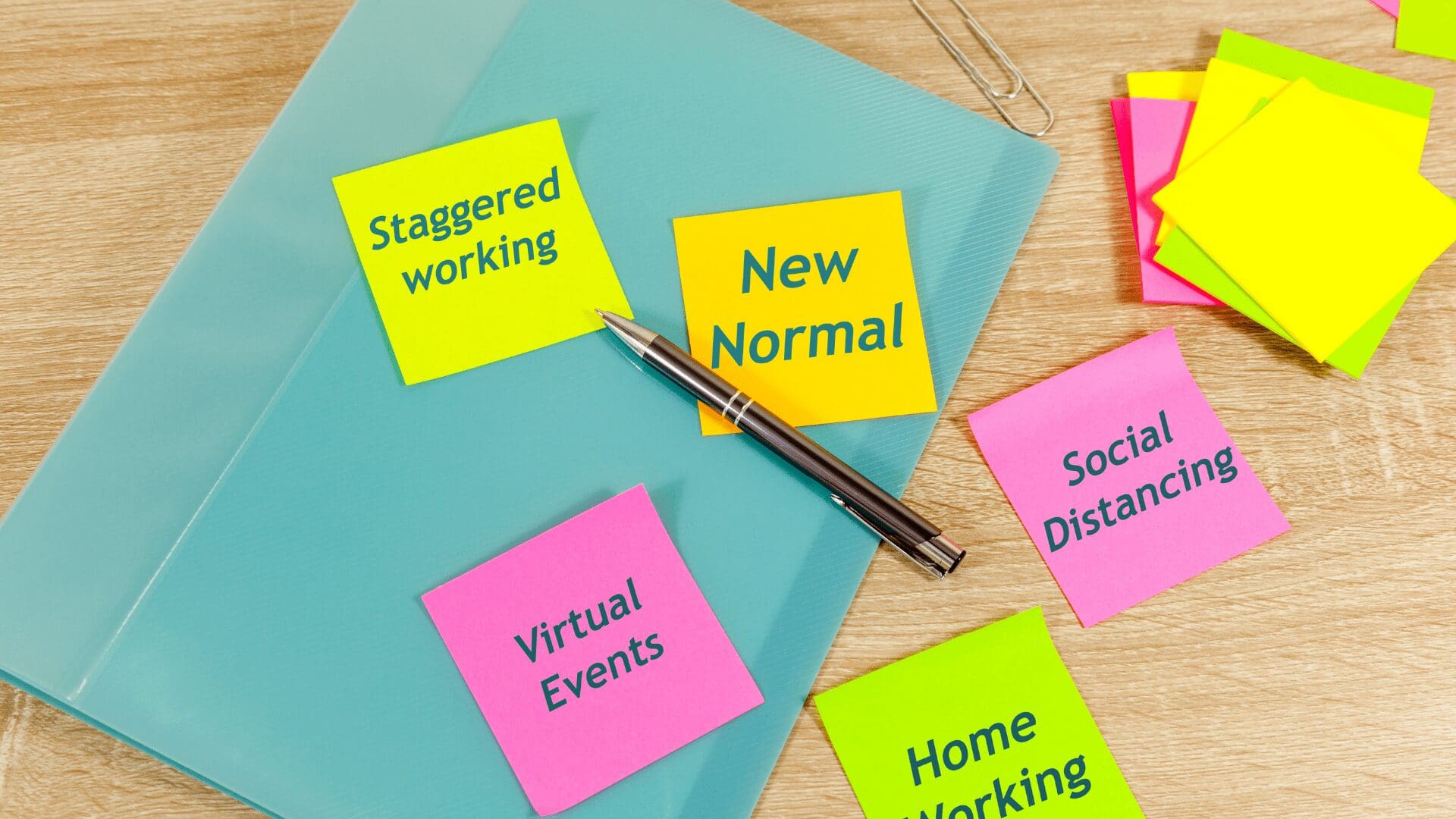As we get well and truly stuck into the New Year it is apparent that what was the ‘norm’ is now not the ‘norm’, so we ask the question, what is the new ‘norm’ when we return to what was the norm!? What is the new hybrid working?
The answer is more than likely a combination of pre COVID ‘norm’ and lockdown ‘norm’ (a hybrid of combinations). It is the responsibility of the employers and the HR professionals to now interlink these two and create working processes, policies and procedures which accommodate both and are robust enough to withstand any changes that may come our way this year.
As we start to think about coming out the other side of lockdown, employers are starting to think about integrating staff back into the workplace and what this will mean to the business. The process of returning to the workplace is challenging and a great deal of reflection, reviewing and planning needs to be completed in order to make the process as non-stressful as possible.
At the same time, the same amount of resources needs to be invested into how your staff are going to feel and their thoughts on returning to the workplace.
If the last 12 months have taught us anything, it’s that we have all been united by a common crisis but we have all experienced it in many different ways.
The myth that flexible or remote working was not possible within an organisation now carries no weight so working practices and employment terms may now need to be reviewed and adjusted. Important to remember there is a difference between an employee exercising their rights and applying for flexible working and the new potential hybrid/agile working. Consideration to a shift in working patterns and allowing employees to take more responsibility in the planning of their own workload throughout the day and week will need to be considered and catered for, after all, we have all got this far, and this has been with added complications such as homeschooling and being unable to meet in person!
Whilst there may be a high percentage of staff that are desperate to return to the workplace there will also be a high percentage of staff that will feel anxious about returning to work.
This is where an employee centric culture will benefit the business in terms of successfully finding a new back to normal working practice. HR professionals will need to work hard to establish clear communication channels with staff and find out how every member of staff feels about returning to work, what their individual circumstances are and how the business can accommodate and support each member of staff.
There may be a number of factors that might be worrying staff members, such as the possibility of schools closing again, having an elderly relative at home who they wish to protect still, maybe they have lost a loved one to COVID and are not emotionally ready to return to work, the truth is there is are a number of circumstances that all need to be identified and then a solution found to ensuring that the correct support is available.
There needs to be consideration given to not just staff that have been working from home, but also the needs of staff that were furloughed and contract, temporary or outsourced individuals that need to be integrated back into the workforce. Their needs will be very different, they may be suffering from isolation and more than likely will not have been kept in the communication loop for the business, so potentially some staff may feel very removed and the prospect of returning will be daunting or potentially not even what they want after all of the turmoil of the past 12 months. The business is likely to have changed and adapted to the situation, and absent staff will be at a disadvantage in terms of knowledge and training, so thought has to go into how to get them up to speed so that they are not at a disadvantage and made to feel inferior.
It is also worth considering how as a business you might like to reward your employees for their efforts over what has been such a challenging time. Whilst employers have been facing the day to day challenges of running the business, the frontline staff have also been under immense strain to carry on their roles for your business, whilst at the same time facing their own personal challenges.
Sharing devices, Wi-Fi, taking calls in between homeschooling or the worry of redundancy has meant that employees’ lives have not been easy either. Finding a way to celebrate the success of riding this storm collectively will also be paramount in the rebuilding of your workforce.
Finding ways to reward their achievements and acknowledge, their efforts will be greatly appreciated. If the business has changed direction there may be different opportunities for the staff to consider within the organisation – the potential for promotion, side stepping, retraining, or gaining new qualifications, all meaning new or amended HR procedures and policies.
There may be a requirement to support staff who have suffered with stress and consideration to the wellbeing of individuals will be vital to their personal and professional development.
Out of date qualifications or employees who have missed vocational training will also need to be considered and procedures put in place to ensure that the member of staff are not penalised because of the past 12 months.
Consideration should be given to the staff who request to continue working remotely as they found it greatly improved their efficiency and work life balance. Removing the daily commute for some was a real blessing and the hours saved each day may have been put to much greater use in terms of productivity. It may also have a cost saving to your business, in which case do the staff budgets reflect this for the coming financial year?
If there are a number of staff that have found this working practice to be more beneficial is there a policy in place to accommodate this, can the business support them in terms of facilities, training, development, communication and ensuring that they still feel connected to the business?
The new ‘norm’ is a combination of understanding your employees’ needs and catering for them. Whilst the shape of your business may change, your employees are still your most important asset and they need to be supported, encouraged and allowed the flexibility to work in the best way that suits them and your business. It is the job of HR professionals to ensure that this happens and that the business is best placed to thrive and benefit from it.
So, what should we do next?
- Sit down with your stakeholders, business owners and understand what is possible. Review the business and put a plan in place with an agreed timeline, which covers the various areas and functions that support your employee life cycle and business. With the thought process of what was possible and what the new organisation will look like going forward. The following are some of the recent Myths about hybrid work force models and where we need to support our stakeholders to think differently:
- Our existing remote work strategy will work for a hybrid workforce
- We need in-person contact to sustain our culture
- Employees are less productive outside the office
- Hybrid workforce models hurt diversity, equity and inclusion (DEI) strategy
- We need to monitor and measure what employees are doing
- A hybrid workforce model duplicates our IT infrastructure
- Our jobs just can’t be done remotely!
- Plan Regular Pulse surveys. Pulsing employee groups about their work experience, and what they need from the organisation to feel connected and heard, ensures everyone has a voice, and allows you to identify new practices, from flexible work schedules to additional hardware or software for differing needs.
- Think about re-boarding your employees, remembering the importance of your organisation’s values and culture and what makes you as an organisation different to others. Collaboration, agility and trust are increasingly important cultural values in resilient organisations and don’t relate to physical location.
- Review your current policies & contracts – They are mainly all based on individuals working from a permanent location. Don’t forget to go through the correct process where you may have contractual changes.
- Review your performance management tools, make sure you are not breaching human rights and privacy legislations. Consider success measures in two broad categories:
- Workforce outcomes: Track employee performance in relation to business objectives, effective collaboration across teams, behaviours that demonstrate a culture of trust and accountability, a seamless and consistent employee experience, and prioritised mental and physical well-being of all employees.
- Business outcomes: A cost-optimised workforce footprint, a strengthened employer brand and strong contributions to revenue from innovation exemplify measures of success. Track improvements such as reduced costs, increased revenue, greater process efficiency, more business opportunities from cross-site partnerships and the ability to attract diverse, high-quality candidates.
- Identify where and how to invest in the employee life cycle for the greatest returns on a hybrid workforce, including more employee engagement, expanded career options and improved well-being.
- Ensure the workforce is fully supported in a hybrid model. Examples might include adapting facilities and workspaces, providing technology support, and redesigning workflows and processes.
- Review and invest in cloud-based services. Cloud providers deliver reliable service regardless of worker location, while allowing enterprises to quickly shift capacity in response to disruption.
As per my previous articles we need to be proactive and agile, forward thinking and flexible in our thought process. Be willing to change and adapt. Utilise the skill sets you have within the organisation but also don’t be afraid to look at the resources and tools available outside of the business. Organisations and businesses that we support need to think differently and as HR we can often be seen as the stumbling block to progress and change, in many cases we are the voice of reason but we also need to work with our stakeholders to find solutions that are commercially and strategically beneficial.
Author: Pem Paddick (Chartered MCIPD), Director, Treenhill Consulting Ltd
www.treenhill.co.uk | info@treenhill.co.uk
Pem has over 15 years’ experience of working within the corporate and commercial environment as a strategic HR & Finance Director, Business Partner to Board of Directors and Senior Leadership team. Combining working expertise and knowledge gained, she and her associates assist client businesses to gain the maximum from their HR function whether in terms of the quality, development and retention of staff, strategic business growth or managing a range of HR projects.





